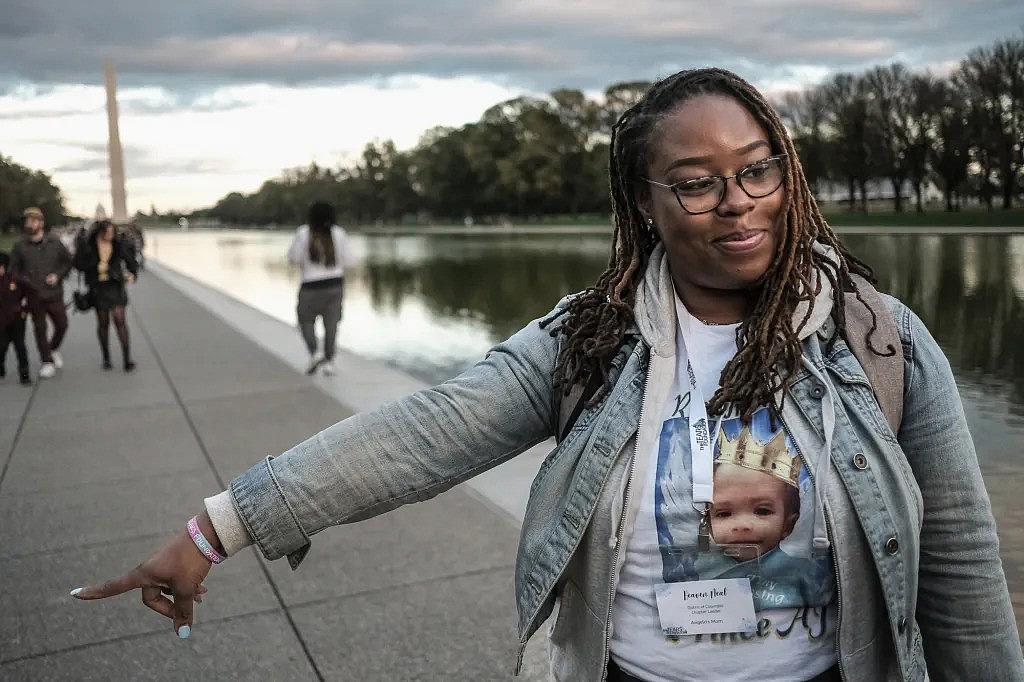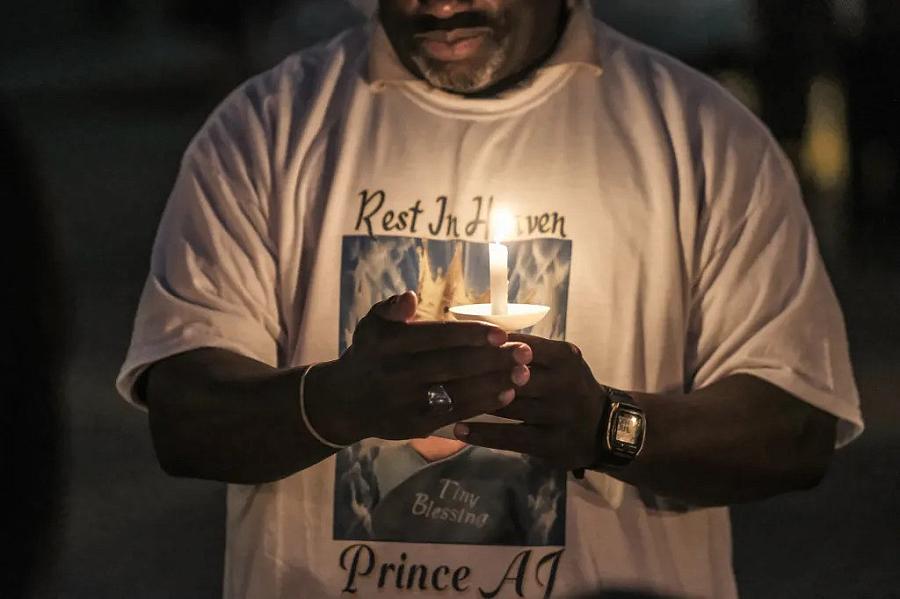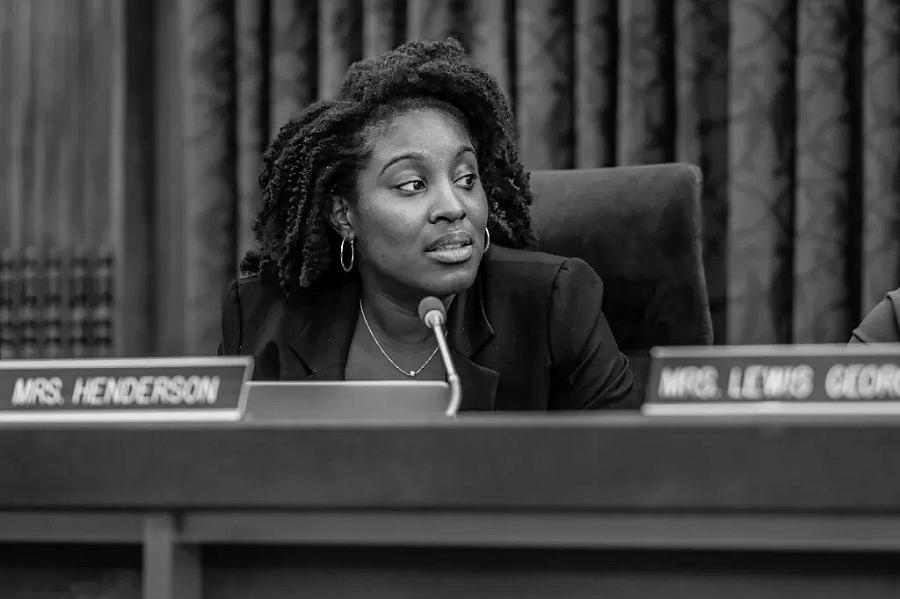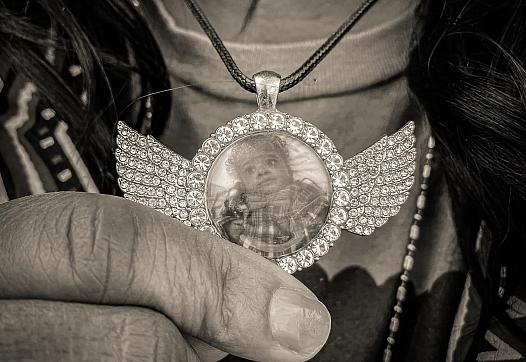Black Infant Mortality in D.C., Part III: Where Do We Go From Here?
The story was originally published by the Washington City Paper with support from our 2023 National Fellowship's Dennis A. Hunt Fund for Health Journalism.

Heaven Sturdivant-Neal
Darrow Montgomery
On a balmy early evening in October 2023, Heaven Sturdivant-Neal is organizing a small group of faithful and supportive family members at the Reflecting Pool in front of the Lincoln Memorial. She does her best to balance the phone calls, questions, playful exchanges, and hugs with her sons Camden, 5, and Cairo, 2. They are assembled in front of a poster board with a photo of her infant boy, AJ, with big brown eyes and chubby cheeks. A crown adorns his head. The family is wearing shirts with the same photo.
“Rest In Heaven Prince AJ,” the caption says.
The group is preparing for the second annual National Remembrance Walk & Candle Lighting Ceremony in honor of D.C.-area children who died. Sturdivant-Neal became involved with the event through her role as president of the D.C. chapter of the TEARS Foundation, a nonprofit that provides bereavement care to families who have lost a child. She wasn’t sure she wanted the role at first. It’s not always easy to console others while dealing with her own grief.
“Even though I do feel like this is what God’s purpose is for me, I also feel like I have to prepare myself for events like this, to share with other people a level of strength that I don’t always have,” Sturdivant-Neal says. “How can I stay fully equipped to help encourage and inspire other people who are going through the same thing?”

Sturdivant-Neal’s infant son, AJ, died in 2013 at 6 months old.
Darrow Montgomery
Her struggle began in 2013. Sturdivant-Neal, a 31-year-old respiratory therapist, noticed her 6-month-old son AJ was coughing and sneezing at home. She tried the methods she thought would calm the symptoms, but they grew worse. She rushed AJ from her home in Fairmount Heights to Children’s National Hospital in Northwest.
“I took him in on a Saturday. By Monday he started looking different, with no improvement. I was trying to give them different ideas and different therapies to try, but I don’t feel like they were taking me seriously,” Sturdivant-Neal says. “I don’t think they were very aggressive with his care.” At 6 months old, AJ was diagnosed with respiratory syncytial virus, or RSV, a condition that can be fatal for infants.
By Tuesday, AJ was transferred to the ICU. “They tried to put the tube down his throat, but then his heart crashed,” Sturdivant-Neal recalls. “They worked [on him] for about an hour until the doctor turned around with tears in her eyes, mouthing, ‘I’m sorry.’” AJ died on April 2, 2013.
These days Sturdivant-Neal is turning her pain into advocacy. She continues to work in respiratory therapy as a consultant and provides CPR training for families with infants. As a respiratory therapist, she wants people to know how to respond in emergency situations if they find their loved ones unresponsive.
“One of my main goals is to work with families, new parents to make sure that they know CPR, because SIDS is very prominent, and I want people to know how to respond if they were to walk into a room and see their child in distress,” Sturdivant-Neal says. “So that is my primary goal, to make sure people know how to save a life.”
D.C. has the fourth highest fetal mortality rate, also known as stillbirths, in the country. The loss of more than 330 Black infants in six years in D.C. is no coincidence. It is the consequence of decades of neglect in maternal health care and education in the Black community.
But there is some hope. Birth workers, doulas, midwives, and social services providers in the city are working to lower the rate of Black infant death. And the Home Visiting Services Reimbursement Act of 2023, introduced in June by Ward 1 Councilmember Brianne Nadeau, and unanimously approved by the rest of the D.C. Council in January, aims to provide steady funding for an evidence-based home visiting program designed to improve infant health. But because the bill was passed “subject to appropriations,” it will take collaboration between the mayor and the Council during the upcoming budget season before its provisions can go into effect.
In the meantime, other programs offered by nonprofits and hospitals aim to reduce the infant death rate by focusing on implicit biases in maternal health care and supporting a postpartum care plan.
D.C. Safe Babies Safe Moms Program
The D.C. Safe Babies Safe Moms Program, offered at MedStar Washington Hospital Center, trains hospital personnel on how to detect their own implicit biases and provide judgment-free care. Expectant mothers and birthing persons receive biomedical and mental health support and connect with social support through the program as needed.

Butterfly ornaments representing the infants who have died in D.C. on display during the second annual National Remembrance Walk & Candle Lighting Ceremony
Credit: Darrow Montgomery
Carol H. Edgar, ambulatory nurse coordinator for MedStar Health Obstetrics and Gynecological Specialty Care Clinic, says the program aims to address racism and trains their staff how to help patients beyond their pregnancies.
“We started from the grassroots, and we started with educating our team on systemic racism,” Edgar says. “And it wasn’t just the doctors or just the nurses, it was everybody from our front desk associates to our midwives. Every fourth Friday of the month we would shut down the practice. We all came on to Zoom and we had social workers and therapists talk about personal biases and give the history lesson that isn’t taught in school.”
Jashia Tiara Pinkney, a nurse midwife at MedStar, says knowing the background of a patient’s community and the limitations they face creates a fuller understanding of the outcomes.

At-Large Councilmember Christina Henderson
Credit: Darrow Montgomery
“We teach new providers about racial bias so that when they are working with patients, they deal with their own racial bias first,” Pinkney says. “We talk about things that people don’t talk about like redlining and how Black people couldn’t buy homes in certain areas. So they may live in a food desert. And so you may think the patient’s being difficult by not eating well, but really there’s no place where they can get good food.”
The program also offers support throughout the pregnancy to ensure that the mother’s health is preserved while delivering a healthy baby. Pinkney says that addressing the mental and medical needs of a parent affects the development of the baby.
“The stress that a mother has in her body will be felt by the baby,” Pinkney says. “Also, things like gestational diabetes and hypertension can affect the placenta and how the baby gets nutrition.”
The ‘Fourth Trimester’
Quality prenatal care is one part of keeping Black babies healthy. It is equally important to have a postpartum plan for the “fourth trimester,” after the baby arrives, that includes social support.
At Mamatoto Village in Northeast, birth workers and caseworkers collaborate with expectant parents to ensure that the social determinants of the mother and baby’s health, such as housing, employment, family support, and transportation to health care appointments, won’t interfere with caring for their newborn and raising their family. Aza Nedhari, executive director and co-founder of Mamatoto Village, says their program focuses on educating parents to create long-range plans for babies to thrive.
“For me, it’s not just about being well during pregnancy, but being well overall. It’s not just about your baby getting here safely in this one moment but how do we set you all up for wellness along the life course?” Nedhari says. “Yes, let’s get through this pregnancy. But how are you feeding your child now and in the future? How are you parenting?”
Nedhari adds that advocating for their clients at hospitals and doctor visits plays a huge role in keeping Mamatoto babies healthy. “We [at Mamatoto Village] do have a very, very, very, very low infant death rate, but that does come with a lot of effort. It’s the advocacy piece where there’s somebody who can say, ‘You know what? We need to get this mom in to be seen right away,’ or ‘That doesn’t sound normal. Let’s get you to where you need to be,’” she says. “But that includes advocating that your voice is being heard right, and that your concerns are being addressed expeditiously.”
Mary’s Center Home Visits
Mary’s Center’s home visiting program brings prenatal support into the home. Home visits are a convenient intervention used to keep expectant parents engaged in their care. Workers have regular appointments with patients to discuss birth plans, modes of delivery, and stages of fetal development. Mary’s Center also connects them to prenatal care and social services.
Meeting the client where they are is the primary goal of the home visiting program under the umbrella of the Nurse-Family Partnership Program, a community health program that matches nurses with first-time mothers to offer guidance from pregnancy until the child’s second birthday. Mary’s Center runs four of 17 individual home visiting programs in the District. The programs are a blend of home and in-person visits that complement prenatal care.
“It’s all about helping people figure out what the barriers are and how they can be addressed,” says Evgenia Ogorodova, nurse home visitor at Mary’s Center. “Is it transportation that’s preventing people from getting to their appointments? Is it their work schedules and they’re not getting the accommodations that they’re entitled to?” Ogorodova spends time reviewing how to use a blood pressure cuff, how to monitor fetal movement, and signs of potential problems with the moms she coaches.
Ogorodova adds that education makes a difference in elevating care. “Oftentimes people come away from a visit with a clinician with questions, and they don’t feel empowered to ask questions. So we can provide that kind of education that may be really helpful,” she says.
Mary Katherine West, program manager for early childhood at DC Action, a children and youth advocacy group, explains in an interview how the home visiting program’s holistic approach to prenatal care helps mothers provide the best environment for their babies to grow.
“The home visitors provide some wraparound services and that includes connecting families with resources that they might otherwise be struggling to access,” West says. “And this could be because a lot of social services have really high barriers to entry, including documentation and paperwork that can take a lot for families to get together. Home visitors can assist with SNAP or WIC applications or even rental assistance if needed.”
The Home Visiting Services Reimbursement Act
Home visiting programs require consistency, which can come with a high price tag. Nadeau introduced the Home Visiting Services Reimbursement Act of 2023 in June. The bill was approved by the full Council in January, but it became law without Mayor Muriel Bowser’s signature. Bowser says in a Feb. 5 letter that she is supportive of the bill in principle, but raised concerns over the cost: $34.8 million over four years. Bowser’s office did not respond to a request for comment.
“The Council must identify how it intends to pay for such costly legislation—particularly as the District faces significant budget pressures,” Bowser’s letter says.
The bill requires Medicaid, the DC HealthCare Alliance Program, and the Immigrant Children’s Program to cover and reimburse eligible home visiting services. But those provisions won’t go into effect unless the Council allocates funds for the program in the upcoming budget process.
At-Large Councilmember Christina Henderson, who chairs the Council’s health committee, says the District is not on tap to pay the full amount.
“The good news is that the federal government will cover a portion,” says Henderson. “In [fiscal year 2025], the bill will cost a total of $8.2 million—$3 million of which is local and $5.18 million in federal. The Mayor’s reference to $34.8 million over the financial plan are the local and federal costs combined. The share of that which the District would be responsible for is $12.8 million.”
Henderson is hopeful that Bowser will implement the program if the Council is able to find the funds to pay for it.
“My colleagues and I will continue to work with the Mayor’s office through the upcoming budget process to identify funding and move this policy forward,” she says.
There was strong community support for the program during the October public hearing on the bill. Henderson says she supports the bill, in part, because it allows families to receive assistance after normal business hours.
“A lot of our [infant] mortality deaths are around sleeping and accidents. But who do you call in the middle of the night when you have a question, or [when] something doesn’t seem right?” Henderson says. “And so for some of our pediatrician offices, they’ll say, ‘Oh, you know, it’ll take a few hours for someone to call you back or those types of things.’ I think with home visiting, by having the consistency of someone who’s checking in on the family, it provides an opportunity to sort of check in on some other things around social-emotional, educational services.”
In the face of personal tragedies, the mothers and birthing persons who continue to speak out in support of solutions to infant death reflect the broader efforts in D.C. to address disparities in maternal and infant health care, particularly for Black families.
From grassroots initiatives such as the D.C. Safe Babies Safe Moms program to comprehensive support systems provided by organizations like Mamatoto Village and Mary’s Center, there is a concerted push to empower and uplift expectant parents. The passage of the Home Visiting Services Reimbursement Act signals a significant step forward in providing accessible and equitable care to those who need it most.
“We know what works,” Henderson says. “We know what is necessary and needed to help improve the horrific numbers that we have here around the District. And so now the question is, do we have the political will to make this a priority to get it done? At least from the Council side, I’m going to do my part.”


